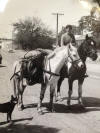 |
Belinda Fane
rode from Gosford, New South Wales to Perth in Western Australia in 1963. |
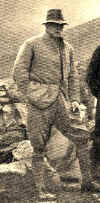 |
Negley Farson
was the grandson of an American civil war general who rode with Sherman as
they burned Georgia from Atlanta to the sea. Perhaps that is what gave the
young man his life-long thirst for adventure? Farson flew with the Royal
Flying Corps during the First World War, took part in the Russian
revolution, was present at the arrest of Gandhi, and went on to become one
of the most celebrated international journalists of his day. Yet one of
Farson’s adventures stands alone, his equestrian exploration of the Western
Caucasus mountains. The intrepid reporter saddled up in the spring of 1929,
accompanied by an aging, eccentric Englishman who lived in Moscow. With no
prior equestrian travel experience between them, the two would-be explorers
were soon discovering the harsh realities of life on the road. They were
lashed by hailstorms, threatened by sceptical Soviet commissars, denied
shelter by suspicious natives, and spent night after night in rain-soaked
misery. A personal chronicle of an already exciting life,
Caucasian Journey
tells how Farson also discovered the seldom-seen splendours of this
mountainous region with its alpine snowfields painted gold by the sun,
picturesque villages forgotten by the outer world, and magnificent horsemen
who were practically born in the saddle. |
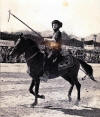
|
Raffaele Favero -
Described as “a
restless victim of the Ulysses syndrome,”
Raffaele combined an artistic soul with the courage of a wandering lion.
Born in Milan in 1945, he was the drummer in Italy’s famous band,
The Prophets.
Yet a strong desire to travel resulted in Raffaele journeying overland to
Pakistan. There he converted to Islam, changed his name to Rafiullah and
studied with the renowned Sufi, Sayid Mir Sain Baba. After becoming fluent
in Pushtu, Rafiullah travelled to Kabul, where he met Sean Jones and Kevin
Rigby. Having read Joseph Kessel’s book,
The Horsemen,
Rafiullah urged the two English travellers to join him in an equestrian
journey across Afghanistan. The three friends formed
The Company of
Horses and rode from Kunduz to Kabul in 1973. Soon afterwards they
decided to ride across the Khyber hills and take up residence in Swat
Pakistan. During this second journey Rafiullah and his companions were
Captured by Afghan Bandits. After his escape from the Afridis,
Rafiullah married fellow traveller Jill Hutchings and immigrated to her
native Australia, where they became the parents of three children, Adam,
Jana and Rhea. The Soviet Union’s invasion of Afghanistan in 1979 resulted
in Rafiullah becoming deeply involved in the jihad against the communist
government. In his book “To
Die for Kabul,”
Italian journalist Lucio Lami expressed his hope for “the arrival of a
courageous reporter who would tell about the massacres carried out by the
Soviets.” Next to that sentence, Raffaele had noted in pencil: "Rafiullah".
Armed with his camera, Rafiullah filmed Afghan children who had been
disfigured by the treacherous “butterfly” mines and risked his life to get
footage of the deadly Hind-24 helicopters that were devastating the
resistance.
Rafiullah died in 1983 while filming a captured Soviet tank. During the
funeral oration renowned guerrilla leader Jalaluddin Haqqani said, "Believe
me, thousands of people have died but I have never felt the pain I feel
now." The Long Rider turned mujahadeen was
buried
in Kabul. In 2006 a book entitled
Rafiullah
explained how “he could not just be a witness. He had to give part of
himself in exchange for the stories he collected.” Determined to document
her husband’s fearless participation in the war of liberation,
Jill Favero
created a documentary entitled “Frontline
Afghanistan.” |
 |
Jean Paul Ferrier
was a
Frenchman who travelled through Afghanistan in the early 19th
century. Ferrier rode from Tehran, Iran to Kandahar, Afghanistan in 1845,
during which time the young Long Rider adapted local clothes and customs. In
the course of this hazardous journey, Ferrier was captured, imprisoned and
tortured by corrupt local rulers. |
 |
Celia Fiennes
- rode from Land's End, Cornwall, England, to Aitchison Bank, Scotland in
1697. |
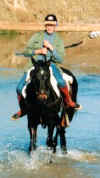 |
Louise
Firouz - travelled widely in her adopted homeland of Iran, and was
largely responsible for saving the Caspian breed of horses |
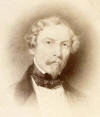 |
Eugène Napoléon Flandin (1809 – 1889) was an archaeologist who
explored Persia in 1839 along with his fellow French Long Rider Pascal Coste.
The two men visited Tehran, Ispahan and Shiraz. Their journey home forced
them to ride through the mountains of Kurdistan which required great
courage. Upon his return to Paris, the government awarded him the Légion
d’honneur |
 |
Henry N. Flynt - took his daughter Juliet and
son Henry Jr. on a horseback journey from Connecticut to Canada in 1935. |
 |
It was 1937 and few places on Earth were more
remote than Afghanistan. Into this hermit kingdom went Ernest Fox.
Technically searching for oil and gemstones for the Afghan king, the
American engineer discovered a countryside unchanged since the days of Marco
Polo. For a year Fox rode a series of local horses through the mountains,
valleys, and deserts of this forbidden realm, visiting such fabled places as
the medieval city of Herat, the towering Hindu Kush mountains, and the
legendary Khyber Pass. The equestrian engineer thus spent an exciting time
on his sojourn, exploring a country which had been a highway for history
since the days of Alexander the Great. Fox's book,
Travels in Afghanistan, was compiled from the field notes,
maps and sketches Fox brought back from his 2,000 mile horse back adventure. |
|

|
Captain Charles
Colville Frankland was an English naval officer, turned Long Rider, who
set off in 1827 to explore the Ottoman Empire and Egypt.
During the course of his
two-year journey Frankland made an extended equestrian exploration of Syria,
at which time he adopted Turkish riding clothes and met Lady Hester
Stanhope, the legendary English aristocrat who had turned her back on life
in London, preferring instead to raise pure bred Arab horses in the
mountains close to Damascus.
These many colourful
events combined to impress the young Long Rider with the beauty of the life
he had stumbled into.
In his 1829 book,
“Travels to and from Constantinople,” Frankland wrote, “The charm of the
vagrant kind of life which I led for weeks in Syria is inconceivable; its
constant variety, its perfect independence, the excitement of difficulty,
the apprehension of danger, were so many powerful but agreeable stimulants.
My wants were few and easily supplied; my bed was the ground, my covering a
cloak and my canopy the heavens; in such a climate I could desire no better.
I halted when and where I chose and set out again as my fancy dictated. I
could live upon a morsel of Arab bread, content myself with a draught of
water and sit upon the back of my horse from an hour before sunrise until
nightfall without feeling fatigued. Thus I gained prefect liberty and
independence.” |
 |
Lewis Freeman led a
major equestrian expedition across the Canadian Rockies in 1925, in order to
study and photograph the Great Columbian Ice Field. In addition to being a
scientific success, the expedition set the precedent for Long Riders to
incorporate state-of-the-art technology into their exploration efforts.
While 21st century equestrian explorers are quick to bring along
their lap top computers and satellite telephones, Freeman was the first Long
Rider to use radio communication during his journey. The large radio
(pictured here with Freeman and his dog) was carefully packed in a wooden
crate and used to communicate with the outside world. |
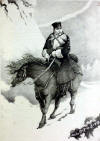 |
The most noted Japanese Long Rider was Baron Yasumasa Fukushima
(1852-1919). This descendant of a noble Samurai family was sent to Berlin,
Germany on military duty in 1892. A fellow soldier, General Rafael de
Nogales, described the equestrian explorer thus, "Fukushima’s courage, drive
and exuberant cheerfulness were amazing. For a man like this nothing was
impossible." When the time came to return home, the Japanese horseman
elected to ride
his horse
Gaisen, (Triumphant Return) 14,000 kilometres (9,000 miles) from Berlin to
Tokyo, Japan. Fukushima wrote a moving story about the fate of Gaisen.
The extraordinary journey quickly became a legend in Japan.
The Emperor hailed
Fukushima as a hero and adopted his three horses in the name of the Japanese
nation. The ragged clothes of the Long Rider and his whip were placed in a
temple where they were venerated. One important part of Fukushima’s story is
how Long Riders, past and present, influenced each other. In the late 19th
century Fukushima told the European press that he was inspired to take to
the saddle because of the previous equestrian journeys made by
Colonel Frederick Burnaby. At the dawning of the 21st
century a young equestrian traveller named Kohei Yamakawa was
inspired in turn by Baron Fukushima to make the first modern equestrian
journey across Japan. |
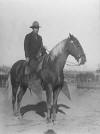 |
Charles Wellington Furlong (1874-1967) led a life
alternately filled with academic excellence and daredevil courage. He
was a superb painter as well as being a foreign correspondent, ethnological
researcher, rodeo cowboy and military attaché. For more information,
please go to this page on our website which shows he was in correspondence
with the most famous Long Rider of the twentieth century, Aimé Tschiffely! |









